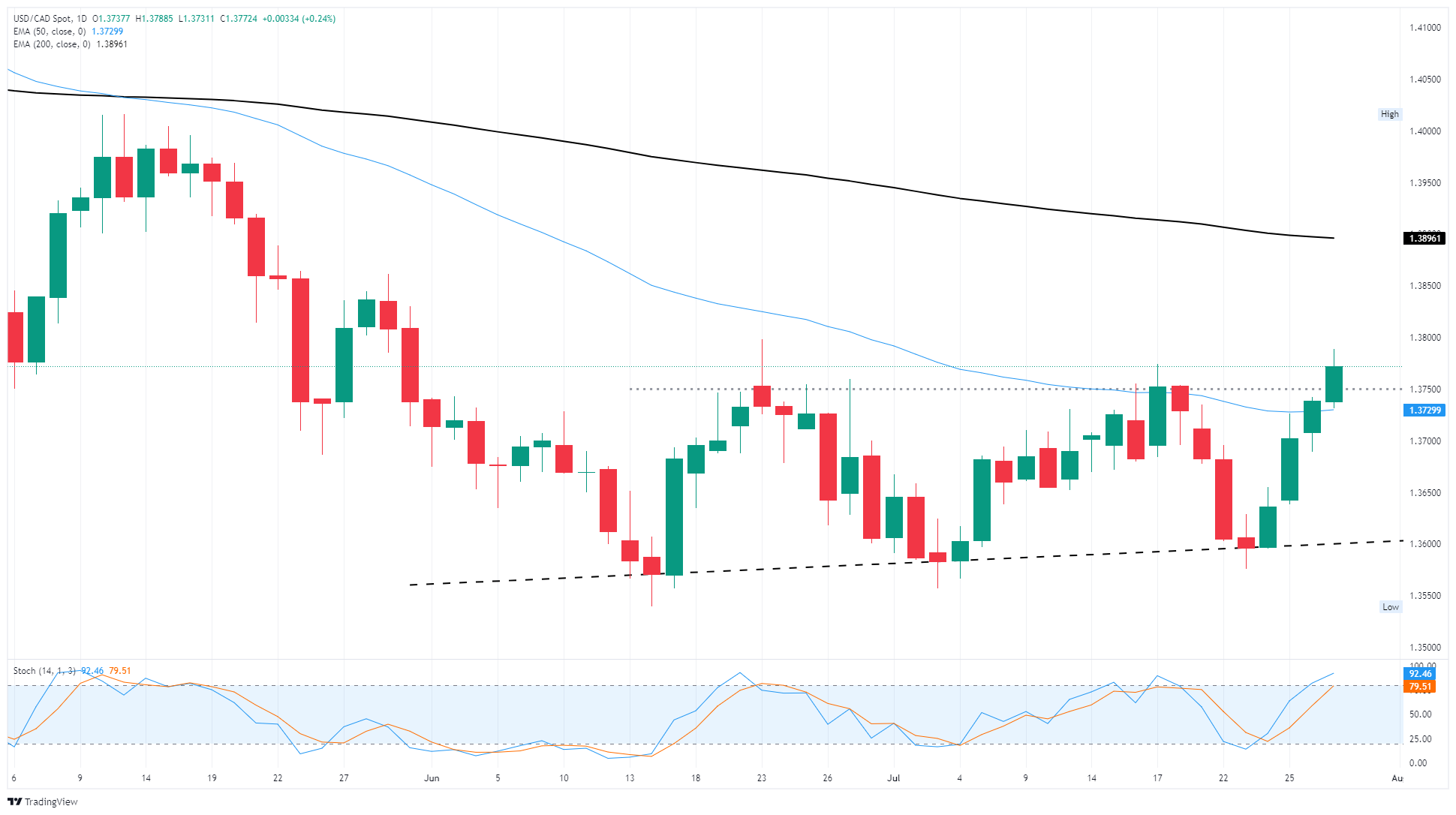Canadian Dollar continues to slide ahead of Fed rate call
- The Canadian Dollar backslid further on Tuesday as the Greenback continues to rise.
- A lack of economic data from Canada leaves CAD traders in the passenger seat.
- Markets are backing into a bullish US Dollar stance ahead of a hefty US data docket.
The Canadian Dollar (CAD) extended into a fourth straight day of losses against the US Dollar (USD) on Tuesday, continuing a Greenback-positive theme in the run-up to the latest interest rate call from the Federal Reserve (Fed). Another hold on interest rates is a foregone conclusion to markets, and investors will be keeping a close eye on the Fed’s rate announcement on Wednesday for signals that the Federal Reserve Open Market Committee (FOMC) is ready to start cutting rates at its next meeting on September 17.
Wednesday will also bring the latest rate decision from the Bank of Canada (BoC). Both the Fed and the BoC are expected to stand pat on interest rates for the time being, but the BoC is poised to be eclipsed entirely by the Fed’s market presence. With safe-haven flows on the upswing and the CAD already stuttering after a rapid series of seven consecutive rate cuts from the BoC earlier this year, the charts could be primed for a fresh round of Loonie losses in the days to come.
Daily digest market movers: Canadian Dollar buckles as traders pivot into US Dollar
- The Canadian Dollar shed around one-quarter of one percent against the US Dollar on Tuesday, bolstering the USD/CAD pair back above 1.3750 and putting the Loonie-Dollar pairing on a collision course with 1.3800.
- Four straight sessions of declines for the Loonie, or rather gains for the Greenback, has pushed the CAD down over 1.5% top-to-bottom over the past week.
- On top of dual central bank interest rate decisions, a slew of high-impact US economic releases is also weighing on this week’s data docket.
- US Gross Domestic Product (GDP), Personal Consumption Expenditure Price Index (PCE) inflation, US earnings, and another round of US Nonfarm Payrolls (NFP) are all on the offering this week, stuffing the data chute.
- Friday, August 1 is also the most-recent self-imposed “tariff deadline” set by US President Donald Trump. The beginnings of some trade deals may be beginning to surface, but concrete details remain woefully light for a country just four days away from a global trade deal deadline.
Canadian Dollar price forecast
Another day of one-sided losses pushing the Canadian Dollar into the basement has given the USD/CAD pair the boost it needs to chalk in a fourth straight green candle as markets broadly favor the safe-haven US Dollar ahead of key events.
USD/CAD continues to grind higher following a messy triple-bottom chart pattern, climbing from 1.3600 toward the 1.3800 handle. Bullish momentum may be poised to slow, with intraday price action grappling with chart territory north of the 50-day Exponential Moving Average (EMA) near 1.3730.
USD/CAD daily chart

Canadian Dollar FAQs
The key factors driving the Canadian Dollar (CAD) are the level of interest rates set by the Bank of Canada (BoC), the price of Oil, Canada’s largest export, the health of its economy, inflation and the Trade Balance, which is the difference between the value of Canada’s exports versus its imports. Other factors include market sentiment – whether investors are taking on more risky assets (risk-on) or seeking safe-havens (risk-off) – with risk-on being CAD-positive. As its largest trading partner, the health of the US economy is also a key factor influencing the Canadian Dollar.
The Bank of Canada (BoC) has a significant influence on the Canadian Dollar by setting the level of interest rates that banks can lend to one another. This influences the level of interest rates for everyone. The main goal of the BoC is to maintain inflation at 1-3% by adjusting interest rates up or down. Relatively higher interest rates tend to be positive for the CAD. The Bank of Canada can also use quantitative easing and tightening to influence credit conditions, with the former CAD-negative and the latter CAD-positive.
The price of Oil is a key factor impacting the value of the Canadian Dollar. Petroleum is Canada’s biggest export, so Oil price tends to have an immediate impact on the CAD value. Generally, if Oil price rises CAD also goes up, as aggregate demand for the currency increases. The opposite is the case if the price of Oil falls. Higher Oil prices also tend to result in a greater likelihood of a positive Trade Balance, which is also supportive of the CAD.
While inflation had always traditionally been thought of as a negative factor for a currency since it lowers the value of money, the opposite has actually been the case in modern times with the relaxation of cross-border capital controls. Higher inflation tends to lead central banks to put up interest rates which attracts more capital inflows from global investors seeking a lucrative place to keep their money. This increases demand for the local currency, which in Canada’s case is the Canadian Dollar.
Macroeconomic data releases gauge the health of the economy and can have an impact on the Canadian Dollar. Indicators such as GDP, Manufacturing and Services PMIs, employment, and consumer sentiment surveys can all influence the direction of the CAD. A strong economy is good for the Canadian Dollar. Not only does it attract more foreign investment but it may encourage the Bank of Canada to put up interest rates, leading to a stronger currency. If economic data is weak, however, the CAD is likely to fall.
